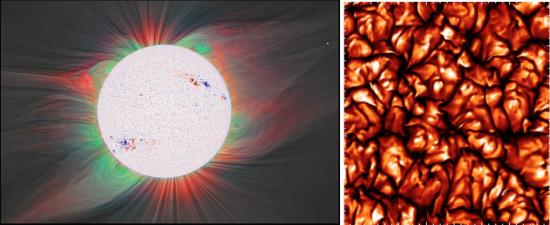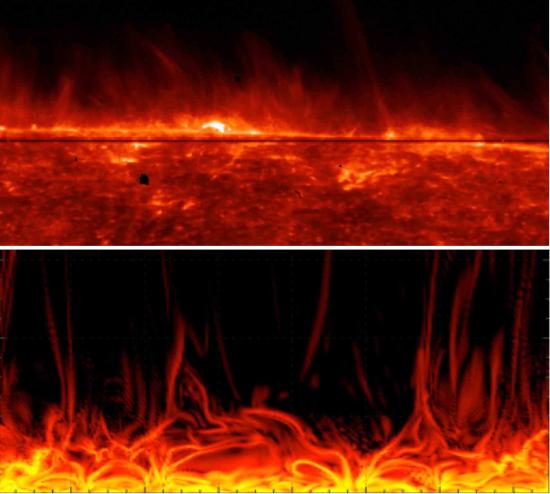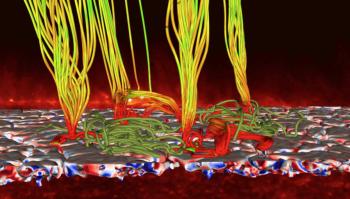How does the temperature of the Sun's atmosphere can reach up to a million degrees, while that of the surface of the star is about 6000 ° C? By simulating the evolution of part of the interior and exterior of the Sun, researchers from Center for Theoretical Physics (CNRS / Ecole Polytechnique) and Astrophysical Department-AIM Laboratory (CNRS / CEA / Université Paris Diderot) identified the mechanisms bringing energy capable of heating the solar atmosphere. According to their study, a layer below the surface of the Sun, which behaves like a boiling pot, creates a small-scale magnetic field acting as an energy reservoir. Once out of the star, this field heats the layers of solar atmosphere via the roots and branches of a magnetic networks [1], similar to a mangrove. This heating of the atmosphere, necessary for the creation of the solar wind that fills the heliosphere, concerns also many other stars. These results appear in the journal Nature on 11 June 2015.
The temperature of the sun, which reaches about 15 million degrees at its heart, decreases gradually falling to 6,000 degrees to its "surface". It should then logically continue to decline into the atmosphere. Yet it reaches about 10,000 degrees in the chromosphere and more than a million degrees in the corona. What is the source of energy capable of providing and maintaining the atmosphere at such temperatures? This issue that is a major problem of astrophysics for about a century, also crucial because it is associated with the source of the solar wind that reaches the Earth.
If it seemed acquired that part of the energy inside the Sun managed to attain these outer layers, the real mechanism remained mysterious. To solve this problem, the researchers focused on the small-scale magnetic field of "salt and pepper" appearance outside spots.

Left. The solar surface and its magnetic field predominantly "salt and pepper" outside the regions of large sunspots, from the SDO-NASA satellite data © SDO / NASA / Tahar Amari Theoretical Physics Centre and S. Habbal / Mr. Druckmüller.
Right: Zoom in on a modeled small portion of the sun's surface, illustrating the temperature of the granulation cells obtained at the surface of a plasma thin boiling layer (warm / light at the center of cells and cold / dark on the edge) below the surface of the sun and responsible for creating the small scale surface magnetic field. © Tahar Amari / Theoretical Physics Center
Efficient numerical models using calculators from Center for Theoretical Physics (CNRS / Ecole Polytechnique) and Idris CNRS allowed to perform a simulation for a few hours based on a model made up of several layers, one internal below the Sun's surface and the others in the Sun's atmosphere. The researchers then found that the thin layer under the surface of the Sun actually behaves as a "pot" of small thickness containing a boiling plasma [2], heated from below and forming "bubbles" associated with granules. This boiling plasma is then responsible for a dynamo phenomenon that amplifies and maintains the magnetic field: this field, coming out of the surface, take a salt and pepper appearance and form fewer concentrations of larger size, with longer life duration, characterized as solar "meso-spots", all consistent with the observations.

Top: the Sun's surface according to data from the IRIS-NASA space mission, with in the background the dynamic structure of the heated atmosphere © IRIS / NASA.
Bottom: High resolution modeling of the solar atmosphere showing the formation of strong electrical currents that rise like flames. © Tahar Amari / Theoretical Physics Centre.
The scientists also discovered that a organization similar to a mangrove appears around these meso-solar spots: entangled "chromosphere roots" plunge between granules surrounding "magnetic tree trunks" that rise in the corona and are associated with the large scale magnetic field.
Their calculations showed that in the chromosphere, heating of the atmosphere is ensured by multiple micro-eruptions occurring in the roots of the mangrove carrying very large electric currents, associated with "bubbles" coming from the boiling plasma. They also discovered that more eruptive and less frequent events exist in the vicinity of meso-spots but are not able to heat the above corona.

Full model illustrating the plasma thin boiling layer, near the Sun surface, responsible for generating "pepper and salt" magnetic field at the surface (blue-red). This field, when emerging, creates a "vegetation" reminiscent of a mangrove, and allows the heating of the various layers of the solar atmosphere. © Tahar Amari / Theoretical Physics Centre.
This eruptive dynamics creates "magnetic" waves along the trunks, not unlike the sound of a plucked string, by propagating along it. These waves then carry energy to the above corona and their gradual dissipation heats it. Their calculations also show that by falling back to the surface, the ejected matter form tornadoes themselves observed. Thin plasma jets close to these trees are also produced and represents the spicules recently discovered. All these phenomena observed individually and unexplained until now are various energy channels coming out from the hot plasma and not the sole source invoked.
The researchers found that the flow of energy of their mechanisms corresponds to that required by all studies to maintain the plasma of the solar atmosphere to its temperature: 4500 W / m2 in the chromosphere and 300 W / m2 in the corona.
Contact : Jean-Jacques Aly
Publication :
« Small scale dynamo magnetism drives the heating of the solar atmosphere » Tahar Amari, Jean-François Luciani and Jean-Jacques Aly published in Nature of 11 June 2015 (click here  for a numerical version)
for a numerical version)
see : the CNRS-CEA press release (10 June 2015)
see also : "Play on the solar rope" (19 octobre 2014)
Notes :
[1] Magnetic field lines are organized in the form of roots and branches.
[2] A plasma, often called the fourth state of matter, is an electrically conductive fluid.
Redaction : T. Amari, DCOM CEA, J.M. Bonnet-Bidaud
